October 28, 2021, marks the 100th anniversary of the birth of Erik Jorgensen, one of Canada’s greatest innovators, the man who coined and popularized the term “urban forestry.” Jorgensen assumed a leadership role in forestry by expounding the benefits of maintaining and managing trees in cities, a concept that was considered revolutionary at the time. He authored over 60 articles and scientific papers on tree diseases and urban forestry and developed studies and techniques to control the spread of tree diseases, especially Dutch Elm Disease (DED).
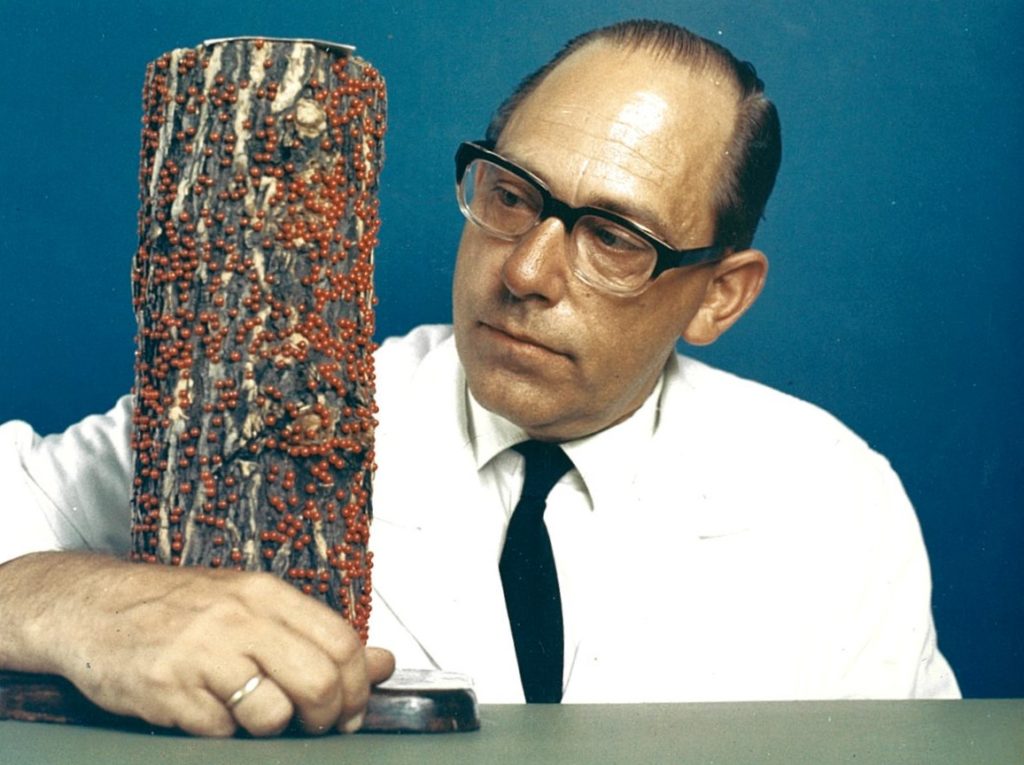
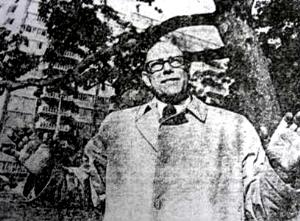
Early Years and WWII
Jorgensen was born in Haderslev, Denmark, the only child of Johanne Jorgensen, a credit manager for a farmer’s credit union, and Eva Bromberg, a ballet dancer who ran a dance school in Ribe, Denmark. Eva was also of Jewish descent, a fact she kept secret throughout her life for many reasons, including the impending Nazi control of Europe. Jorgensen would also be considered Jewish. Like most Europeans, his seemingly normal life changed with the advent of World War II.
In 1940, at the age of 18, the Germans took control of Denmark under Operation Weserubung – sometimes referred to as the Six Hour War, due to its short length. Although he was relatively sheltered from the war being a student at the university, the war would impact Jorgensen so greatly that he could not talk about it for some 50 years.
In 1946, Jorgensen finally graduated with a Master in Forestry from the Royal Veterinary and Agricultural College in Copenhagen. The same year, he married Grete (called “Gitte”) Moller.
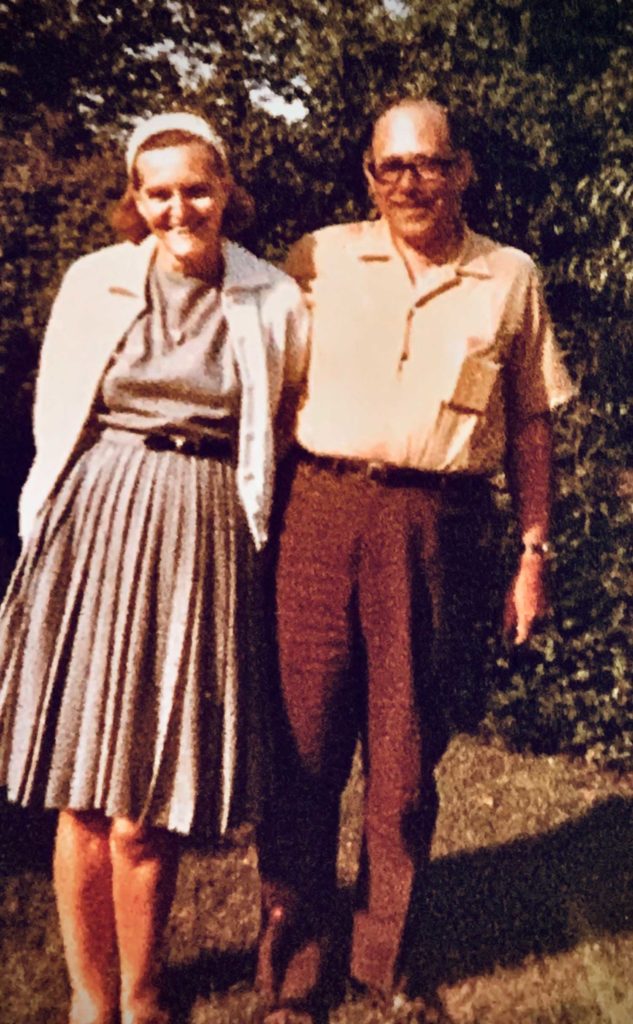
When Denmark was liberated in 1945 it was in many ways a shattered and divided country. With 3,000 Danes killed and much of the infrastructure in the country laid to waste, the country struggled to rebuild. Over 40,000 were arrested for collaboration with the Nazis and sent to the Froslev Prison Camp originally constructed to intern Jews and other “undesirables” by the Nazis (Wikipedia). Denmark created a new post-War army and Jorgensen was conscripted into it from 1946-48 after which he obtained the rank of 2nd Lieutenant (Who’s Who, 1984). His two daughters were born shortly after in Denmark – Marianne in 1948 and Birthe in 1952. Both daughters became educators – Marianne an elementary school teacher, Vice-Principal and Administrator co-writing one of Canada’s first on-line courses in 1998. Birthe graduated with a Ph.D. in law at Cambridge University and taught at Carleton University.
Post War and the Move to Canada
Post-war life in Denmark was difficult. Jorgensen and his wife were forced to live with four other families. Even still, his strong interest in fungi had him create fungal terrariums complete with a new photographic concept, “time-lapse photography,” in his small apartment. In 1946, he began work in the Danish Forestry Experimental Station in Springforbi as well as work as the Assistant in Silviculture at the Royal Veterinary and Agricultural College. In 1949 he was appointed Assistant in Forest Pathology at the Department of Plant Pathology of the Royal Veterinary and Agricultural College with his final Danish appointment occurring in 1953 as a Project Leader at the Danish Forestry Experiment Station in Springforbi.
When a Canadian forest researcher saw a presentation of Jorgensen’s in Holland, he was impressed. Canada’s Dominion Forest Service offered him a 6-month contract as a Research Officer in forest pathology at the field laboratory in Maple, ON. Jorgensen moved the family to Richmond Hill, ON in 1955. The family’s command of English was not wonderful, but everyone quickly learned it as they made every attempt to settle in their new home (Jorgensens, 2021). Interestingly enough, the family moved to several Jewish neighbourhoods in Toronto where the girls grew up, despite Jorgensen never identifying as Jewish. The family however stayed close to the Danish community including the Danish Lutheran church which Jorgensen helped to establish in Toronto.
The Dominion Forest Service asked him to diagnose a problem in red pine plantations in both southern Ontario and Michigan. Ken Armson, a long-time colleague, soils professor at U of T and the last “Chief Forester” of Ontario recalls: “The US Forest Service had investigated the cause without success and trees with symptoms associated with the onset of mortality were said to be suffering from ‘Jones Disease’. Erik told me that as soon as he saw the affected trees, he knew the cause was Fomes annosus.” As a European-trained forester, Jorgensen was often dismayed with the “primitive” nature of Canadian forestry with its reliance on a seemingly endless supply of trees, yet he was committed to professionalism and was an active (if sometime unheeded) life member of the Ontario Professional Foresters Association.
Move to the University of Toronto, Federal Government & Guelph
In 1959 he left the federal service and eventually joined the Faculty in Forestry where he began a program to study the control of Dutch Elm Disease, which was wreaking havoc in the urban forests in eastern North America. The recognition of the importance of elms for Ontario’s communities was sufficient impetus for Jorgensen to establish the Shade Tree Research Laboratory in an old milk factory (the “Borden Building”) bought by U of T in 1962.
In 1964, recognizing the important role that residents and communities would have in controlling Dutch Elm Disease, Jorgensen established the Dutch Elm Disease Control Centre for Metropolitan Toronto & Region, the predecessor of the Ontario Shade Tree Council (now known as the Ontario Urban Forest Council).
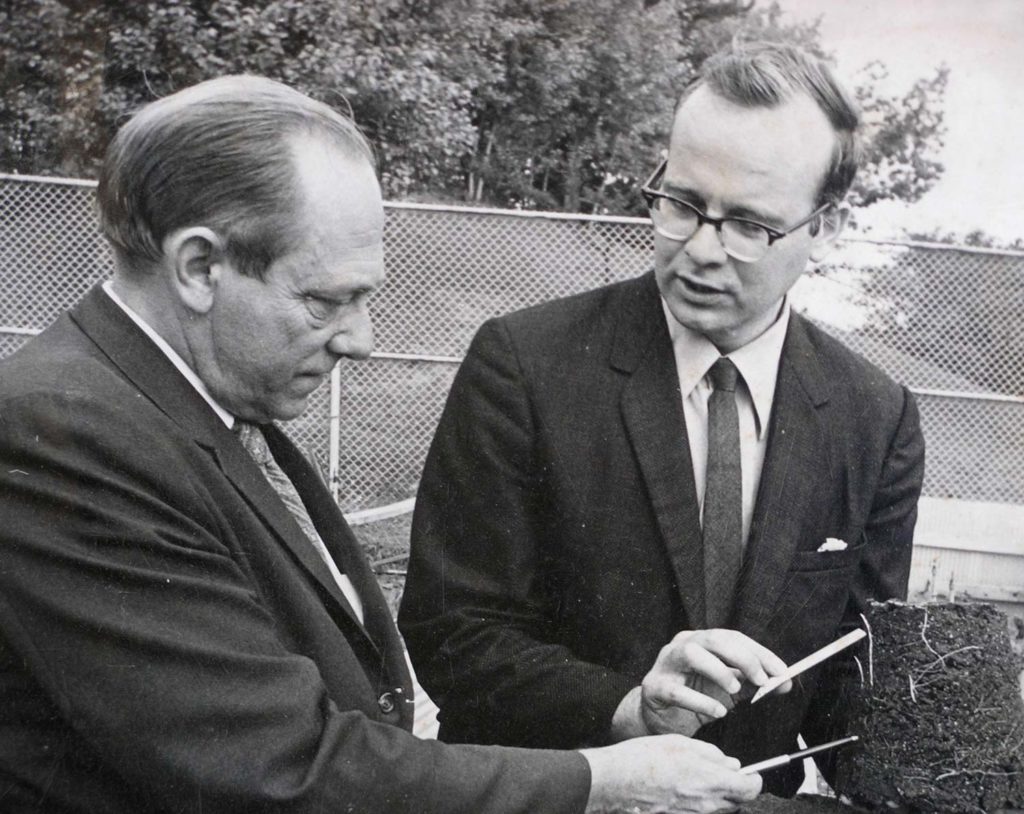
In 1965 he began mentioning, for the first time “urban forestry” which was often considered an oxymoron to those who bothered to listen. However, it has since become a touchstone for those living in urban centres across the world. In 1965 Bill Morsink, a graduate student at the Faculty of Forestry approached Jorgensen expressing an interest in studying aspects of the trees in the City of Toronto. As Morsink put it “Erik Jorgensen had to devise a name for my graduate program other than Forest Pathology; the term had to include Forestry and because my municipal tree studies would be in urban Toronto, Erik devised the catchy term “Urban Forestry” (Morsink 2000). In fact, the term was mentioned as early as 1894 (Cook, 1894) but this usage shared little with the philosophy embodied by Jorgensen. Cook wrote: “…urban forestry, an art requiring special knowledge, cultivated taste, and a natural sympathy for plant life… Good taste demands the observance of two rules as essential in street tree planting. First, that but one variety of tree shall be planted upon a street, and second, that the trees shall be planted at uniform distances.” Kenney even surmised that,“Perhaps Cook’s two rules of “good taste” ultimately aided in the spread of DED!” (Kenney, 2010).
Conversely, Jorgensen (1974) clearly defined urban forestry as: “A specialized branch of forestry that has as its objectives the cultivation and management of trees for their present and potential contribution to the physiological, sociological and economic well-being of urban society. These contributions include the over-all ameliorating effect of trees on their environment, as well as their recreational and general amenity value.” Ricard (2009) suggests that Jorgensen probably never saw Cook’s use of the term as it was published in an obscure report 73 years earlier.
Ken Armson (2019) remembers that under Jorgensen, “… the Shade Tree Laboratory was an autonomous entity within the faculty with separate funding, which inevitably led to conflict within the faculty; a situation I shared in my own development and financial support for the Forest Soils Laboratory at Glendon Hall. This only strengthened our rapport.” Matters came to a head with the appointment of a new Dean in 1972. In 1973, Jorgensen left to join the federal forest service, once again under a short-lived national urban forestry program that never fully developed. From there, Jorgensen became the Director of the Arboretum at the University of Guelph. During his time there, Jorgensen was instrumental in bringing a program in Agroforestry to the University, a discipline that was embryonic in the early ‘80s. “Erik was a visionary,” recalls Dr. Andy Kenney, former professor of urban forestry at the University of Toronto who knew Jorgensen as his Master’s supervisor at the University of Guelph. “Not only did he provide the first definition of urban forestry in the mid-1960s, but he was instrumental in the establishment of a program in agroforestry at the University of Guelph. Both concepts go back to the time of early human civilization, but Erik was in the vanguard of those transforming them into scientific disciplines.”
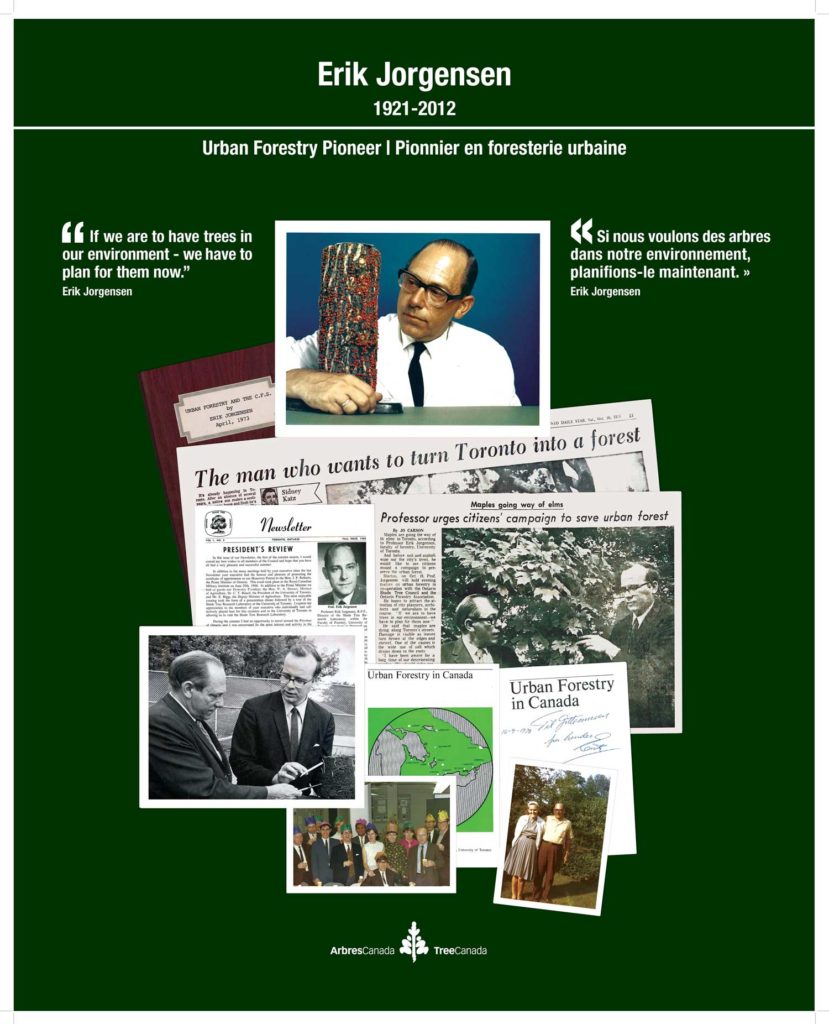
The Erik Jorgensen Legacy
Jorgensen’s legacy is difficult to put into words but many of those whom he taught at the “Shade Tree Lab” went on to lead urban forestry programs throughout Canada and around the world. In 1969, a young forester from India was accepted to complete his Ph.D. in Dutch Elm Disease control at the Shade Tree Laboratory at U of T. Ian Nadar (a.k.a. Ayyam Perumal) went on to direct the National Capital Commission’s DED control program, typical of those who worked with Jorgensen at that time. “Erik was very creative and sought funding from various sources to do research into Dutch Elm Disease”, he recalls. “But at no time did any of that funding go to him – he was insistent that the funds be used to support the work of those carrying out research. Erik Jorgensen was not only totally technically excellent but was also extremely giving and very welcoming of international students at the Shade Tree Laboratory,” he said.
Over the intervening years, “urban forestry” evolved from relative obscurity and an oxymoron to part of the global urban vernacular. Today, cities and towns around the world have programs and departments with the term in their titles. International conferences billed as “urban forestry” have taken place from Reykjavik to Buenos Aires and from Edmonton to Kuala Lumpur (Kenney, 2010). Canadian college departments have incorporated “urban forestry” into their program descriptions. The International Society of Arboriculture, a closely allied organization that Jorgensen supported throughout his career, renamed its influential research journal, “Arboriculture & Urban Forestry”. Consumer products including soaps and cosmetics use the words “urban forest” to describe themselves.
Today, the management of urban forests stress’s themes of tremendous importance, including public health, public policies ranging from asset management to sustainability certification, growth of forestry employment opportunities, and technical advances in vertical forests, hard surface techniques, LIDAR photography and species migration. All of which was made possible through his pioneering work. If he were here to see all this today, there is no doubt he would be proud.
Canadian forestry institutions continue to embrace the concept of urban forests. The University of Toronto now offers “Urban Forestry and Settled Landscapes” as part of its Master of Forest Conservation program the University of New Brunswick offers a B.Sc.F. with a “major” in urban forestry and the University of British Columbia offers Canada’s only Bachelor of Urban Forestry and Master of Urban Forest Leadership programs. Other universities explore urban forest themes.
Urban forestry programs and funding are offered by NGOs such as Tree Canada and Forests Ontario, often mentioned by environmental organizations including the David Suzuki Foundation and the Nature Conservancy of Canada. Local urban forest NGO’s such as Trees Winnipeg and Toronto’s LEAF provide practical urban forestry services and information. As Dr. Cecil Konijnendijk, the Director of the Nature Base Solutions Institute and Professor of Urban Forestry at the University of British Columbia so succinctly puts it, “Many of us urban forestry experts across the globe are gratefully working within and building on Erik Jorgensen’s legacy. There has perhaps never been a greater focus on urban trees and green spaces as we strive to make our cities more resilient, healthy, and vibrant.”
Jorgensen passed away in Guelph on May 25, 2012, predeceased in April 2012 by his wife of 66 years, Gitte. His daughters (Jorgensens, 2021) remember him as, “A great father because of his compassion, a lover of the application of science and scientific methods to all problems in the natural world.” He is survived by his two daughters Marianne La Rose and Birthe Jorgensen, both of whom are very content that the hard work and creativity of their father have paid such rich dividends, his sons-in-law Bob La Rose and David Baker, four grandchildren and four great-grandchildren.
We owe so very much to this wonderful man whose courage, vision and (some would say) “impatience with mediocrity” would bring so much good to the world that we live in today.
To read the complete story, click here.
Literature Cited
Armson, Ken, 2019. Personal communication.
Cook, G.R., 1894. Report of the general superintendent of parks. Second Annual Report of the Board of Park Commissioners, Cambridge, Massachusetts, pp. 71–98.
Jorgensen, E. 1967. Urban forestry: Some problems and proposals. Toronto: Faculty of Forestry, University of Toronto.
Jorgensen, E. 1993. The History of Urban Forestry in Canada. IN The Proceeding of the First Canadian Urban Forest Conference. Winnipeg MB. May 30 to June 2, 1993. Pages 14-18.
Konijnendijk, C.C., Ricard, R.M., Kenney, A. and Randrup, T.B. 2006. Defining urban forestry – A comparative perspective of North America and Europe. Urban Forestry & Urban Greening 4: 93-103.
Jorgensens, 2021. Personal communication with Marianne LaRose and Birthe Jorgensen, daughters of Erik Jorgensen.
Kenney, A 2010. Erik Jorgensen – Canada’s First Urban Forester. In Forest History Society newsletter, Vol 1, Issue 2, Fall 2010, pp. 3-5.
Morsink, W.A.G. 2000. The Ontario Urban Forest Scrapbook. Ontario Urban Forest Council.
Ricard, R.M., 2005. Shade trees and tree wardens: revising the history of urban forestry. Journal of Forestry 103 (5), 230–233.
Who’s Who. 1984. Erik Jorgensen. pp 499-500.
Wikipedia, 2021. Denmark in World War II.
Back to all articles